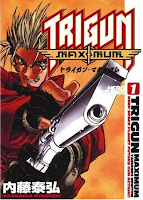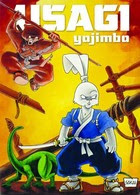My News and Reviews
Two reviews for you all this past week! First up was my review of Edogawa Rampo’s novella Strange Tale of Panorama Island. I enjoyed it quite a bit and am now even more excited for the release of Suehiro Maruo’s manga adaptation of the story, which looks like it will actually be published this year. (I’ve been waiting since 2009.) The second review posted was my monthly Blade of the Immortal review—Blade of the Immortal, Volume 19: Badger Hole. In this volume the women of the series get a moment to shine before the introduction of a new character diverts readers’ attention.
The biggest manga news from last week is that the digital manga service JManga will be shutting down. JManga7 is already gone, but more information regarding JManga’s closure (termination schedule, refunds, FAQs, etc.) can be found here. I personally never got around to using JManga (I still have plenty of print manga keeping me busy), but I am still sad to see the service go.
In happier news, Kuriousity takes a quick look at a couple of One Peace Books’ upcoming manga: Black Bard and Smuggler. Smuggler was previously published by Tokyopop, but Black Bard is a new English license. I’m actually somewhat interested in both titles, but especially in Black Bard since it will be an omnibus release and has a music connection, too. Over at All About Manga, Daniella Orihuela-Gruber takes on a 30 Day Yaoi Challenge. Check out the first post/review to learn more about the project and what’s in store for Daniella and All About Manga readers.
Quick Takes
 Kashimashi: Girl Meets Girl, Omnibus 2 written by Satoru Akahori and illustrated by Yukimaru Katsura. Hazumu is still trying to get used to being a girl, but in the second omnibus she has even more pressing concerns to deal with. While I vaguely enjoyed reading Kashimashi, it hasn’t really left much of an impression. As strange and original as Kashimashi tries to be, it ends up feeling very derivative. I’m not sure if it’s intentional or not, but Yasuna (one of the love interests) reminds me a lot of Tomoyo from Cardcaptor Sakura in both character design and personality. Seven Seas also made the bizarre decision to include the translation notes for the entire series in the second omnibus.
Kashimashi: Girl Meets Girl, Omnibus 2 written by Satoru Akahori and illustrated by Yukimaru Katsura. Hazumu is still trying to get used to being a girl, but in the second omnibus she has even more pressing concerns to deal with. While I vaguely enjoyed reading Kashimashi, it hasn’t really left much of an impression. As strange and original as Kashimashi tries to be, it ends up feeling very derivative. I’m not sure if it’s intentional or not, but Yasuna (one of the love interests) reminds me a lot of Tomoyo from Cardcaptor Sakura in both character design and personality. Seven Seas also made the bizarre decision to include the translation notes for the entire series in the second omnibus.
 Paradise Kiss, Part 3 by Ai Yazawa. I continue to be impressed by the characterizations and complicated relationships found in Yazawa’s manga. Her characters come complete with flaws and are much more interesting because of it. In Paradise Kiss I was particularly pleased to see Yukari’s development and growth as a person. In the beginning, she frequently annoyed me, but as she matures I found her to be a more sympathetic character. Part 3 of the series also spends a little bit of time exploring Isabella’s backstory, which made me happy. (This also includes seeing George as a dapper young boy.) I was very satisfied with the ending of Paradise Kiss. It might not be the happily ever after that some readers hope for, but I think it was the right one and true to the characters.
Paradise Kiss, Part 3 by Ai Yazawa. I continue to be impressed by the characterizations and complicated relationships found in Yazawa’s manga. Her characters come complete with flaws and are much more interesting because of it. In Paradise Kiss I was particularly pleased to see Yukari’s development and growth as a person. In the beginning, she frequently annoyed me, but as she matures I found her to be a more sympathetic character. Part 3 of the series also spends a little bit of time exploring Isabella’s backstory, which made me happy. (This also includes seeing George as a dapper young boy.) I was very satisfied with the ending of Paradise Kiss. It might not be the happily ever after that some readers hope for, but I think it was the right one and true to the characters.
 Solanin by Inio Asano. In the afterword, Asano describes the characters of Solanin as “just your average 20-somethings,” with nothing particularly noteworthy about them. Meiko is a recent graduate who hates her office lady job. And so she quits, even though her savings won’t last that long. Her live-in boyfriend Naruo is faced with a similar dilemma: he doesn’t mind his job as an illustrator, but he would be much happier if his band could make it big. Searching for their place in the world, Meiko, Naruo, and their friends aren’t quite ready to become adults. Solanin is largely a melancholic work, but it has just the right touch of humor and hope to keep the manga from becoming too depressing.
Solanin by Inio Asano. In the afterword, Asano describes the characters of Solanin as “just your average 20-somethings,” with nothing particularly noteworthy about them. Meiko is a recent graduate who hates her office lady job. And so she quits, even though her savings won’t last that long. Her live-in boyfriend Naruo is faced with a similar dilemma: he doesn’t mind his job as an illustrator, but he would be much happier if his band could make it big. Searching for their place in the world, Meiko, Naruo, and their friends aren’t quite ready to become adults. Solanin is largely a melancholic work, but it has just the right touch of humor and hope to keep the manga from becoming too depressing.
 Usagi Yojimbo: Yokai by Stan Sakai. In 2009, Sakai celebrated the 25th anniversary of his marvelous series Usagi Yojimbo. As part of that celebration, Yokai was published as a standalone graphic novel. Although Yokai is written in such a way that newcomers to the series can approach it, established fans will probably appreciate it more. Fans of yokai will also get a kick out of the volume as Usagi encounters a fair number of yokai before the story is through. Which, considering the title, probably isn’t that surprising. What sets Yokai apart from the rest of Usagi Yojimbo is that it is Sakai’s first story to be completely hand-painted in watercolor. The volume also includes a nice interview with Sakai discussing a little about yokai the creation of the work.
Usagi Yojimbo: Yokai by Stan Sakai. In 2009, Sakai celebrated the 25th anniversary of his marvelous series Usagi Yojimbo. As part of that celebration, Yokai was published as a standalone graphic novel. Although Yokai is written in such a way that newcomers to the series can approach it, established fans will probably appreciate it more. Fans of yokai will also get a kick out of the volume as Usagi encounters a fair number of yokai before the story is through. Which, considering the title, probably isn’t that surprising. What sets Yokai apart from the rest of Usagi Yojimbo is that it is Sakai’s first story to be completely hand-painted in watercolor. The volume also includes a nice interview with Sakai discussing a little about yokai the creation of the work.





